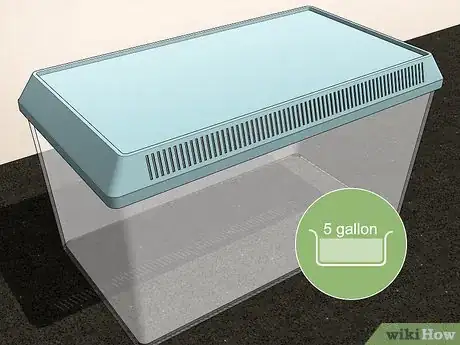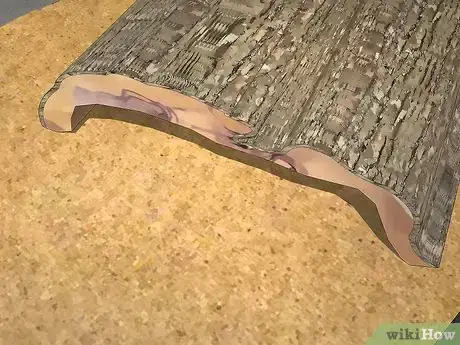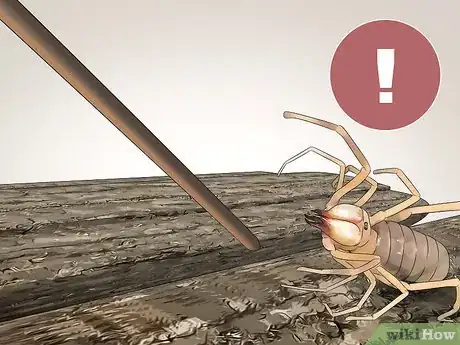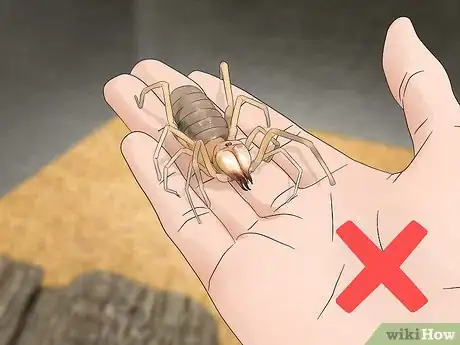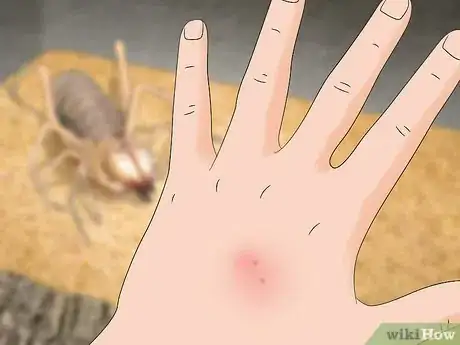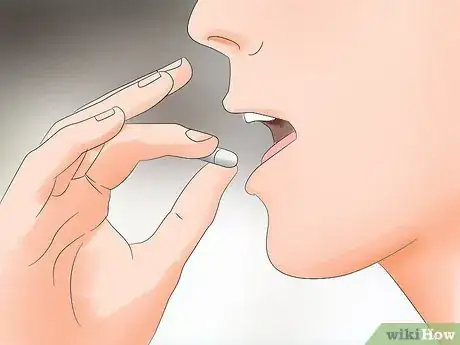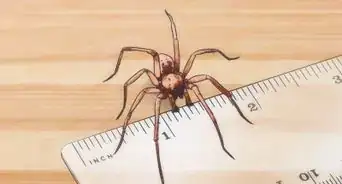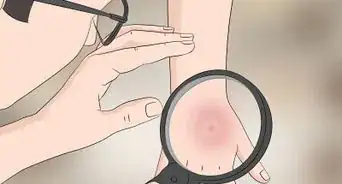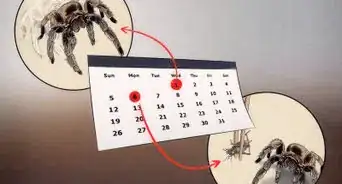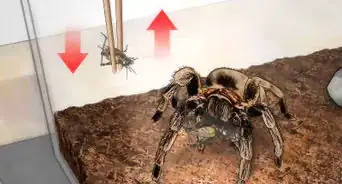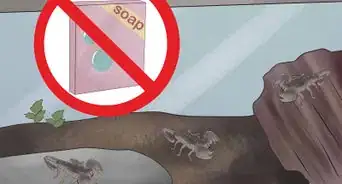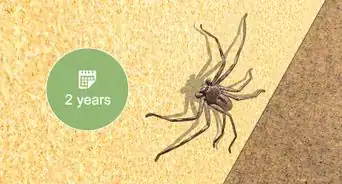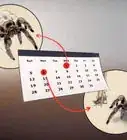This article was co-authored by wikiHow staff writer, Jessica Gibson. Jessica Gibson is a Writer and Editor who's been with wikiHow since 2014. After completing a year of art studies at the Emily Carr University in Vancouver, she graduated from Columbia College with a BA in History. Jessica also completed an MA in History from The University of Oregon in 2013.
This article has been viewed 33,123 times.
Learn more...
If you love exotic pets, you might have your eye on the camel spider. Camel spiders are also called wind scorpions or sun spiders. This unique creature belongs to the species Solifugae. Because it is dangerous, is fast, and requires specific care, you need experience caring for a tarantula or scorpion before keeping a camel spider as a pet.
Steps
Creating a Habitat
-
1Choose a secure tank. Purchase a plastic tank from your local pet store that's at least 5 gallons (19 L) in size. The top of the tank should be escape-proof since camel spiders can climb up the side of the tank. They can also chew through plastic mesh, so the lid material needs to be strong. For example, choose a metal mesh lid with small gaps that the camel spider can't squeeze through.[1]
- Look for aquariums that are used to house tarantulas or scorpions since camel spiders will thrive in a similar habitat.
-
2Fill the tank with 1 to 2 inches (2.5 to 5.1 cm) of sand. Camel spiders frequently burrow throughout the day. Your camel spider may sleep or rest during the day after it's burrowed deep into the sand. It will reemerge at night when the temperature drops.
Did You Know? Female camel spiders lay their eggs in burrows and plug them up. Then they defend the burrow from attacks by other insects.
Advertisement -
3Place branches or bark in the tank to provide cover. If the camel spider chooses not to burrow, it will still want shade and protection. Put several branches or cork bark into the tank so it's on top of the sand.
- You can also place rocks in the tank because these will give the camel spider a shady spot to hide.
-
4Monitor the temperature in the tank. Keep the tank hot during the day and then drop the temperature at night so it's cooler. Place a thermometer inside the tank and raise the temperature of the room that the tank is in until the thermometer reads 95 °F (35 °C). Then turn the temperature down at night so the thermometer in the tank reads between 75 and 82 °F (24 and 28 °C).
- If you prefer, heat the tank with a lightbulb or heated mat.
- Keep in mind that the tank will be hotter than the room, so you won't need to bring the room temperature all the way to 95 °F (35 °C).
-
5Mist the tank every night to increase the humidity. Although camel spiders like it dry during the day, they need high humidity at night. Fill a clean spray bottle with water and spritz inside the tank once a night.
- Misting the tank should raise the humidity level so it's between 70 and 90%. You don't need a hygrometer to measure humidity in the tank, just mist it every night.
-
6Keep a single camel spider in the tank. If you place more than 1 camel spider in the tank, they may attack each other. The camel spider that wins will eat the other camel spider, so it's important to keep multiple spiders separated.
- If you place a female and male camel spider in the same tank, the female will usually eat the male spider.
Keeping the Camel Spider as a Pet
-
1Feed the camel spider a variety of insects every other day. Purchase live crickets and put 1 into the tank every other day. You could also offer locusts, mealworms, or cockroaches. Camel spiders prefer to kill their prey, so try to give it live food that it can hunt.
- Offer the camel spider a frozen mouse once a week as a special treat.
Did You Know? You can set out a shallow dish of water in the tank, but the camel spider probably won't drink from it very much. Camel spiders can get most of their water from their prey.
-
2Leave the camel spider alone if it begins to hiss, rattle, or click. Pay attention to the sound and position of the camel spider when it gets angry or defensive. You'll hear a hissing, clicking, or rattling sound or see the camel spider raise its upper abdomen vertically if it feels like it's in danger. [2]
- The best thing to do if you're interacting with a defensive camel spider is to keep it in its tank and leave it alone until it calms down.
-
3Limit your interaction with the camel spider. Camel spiders can run up to 10 miles (16 km) per hour, so avoid taking it out of its tank to handle it. If the camel spider gets loose, it can escape very easily.
- If the camel spider gets loose and appears to chase you, don't worry. Camel spiders often run after people because they're trying to stay in the shade of the person's shadow. You'll have to be fast to try to place a jar over the camel spider.
Treating a Camel Spider Bite
-
1Recognize a camel spider bite. If you're reaching into the camel spider's tank and it bites you, you'll feel a sharp pain as its jaws dig into you. A camel spider's bite isn't venomous, but it will cause the skin around the bite to become red and inflamed.[3]
Did You Know? Despite popular rumors, camel spiders won't eat flesh or lay eggs inside other creatures.
-
2Clean a camel spider bite immediately. Once the skin around the bite becomes irritated, you need to clean the wound with soapy water or disinfectant. Dry the area and rub on antibiotic ointment. Then cover the area with a bandage.[4]
- It may take a few weeks for the wound to heal completely. Change the bandage frequently to prevent an infection from developing.
-
3Manage the pain of the camel spider bite. Because a camel spider bite can cause severe pain and inflammation, take over-the-counter (OTC) pain medication, such as ibuprofen or acetaminophen. To reduce the swelling and numb the site, apply ice packs for 10 minutes at a time as frequently as you need to throughout the day.
- Call your doctor if the pain doesn't go away after taking OTC medication or if the pain gets worse.
Finding a Camel Spider
-
1Consider your skill level in caring for a camel spider. Most pet stores recommend that you have some experience in caring for scorpions or tarantulas before you try to care for a camel spider. This is because they're very aggressive and need a precise habitat.[5]
- A pet camel spider will also eat a lot of food so be prepared to purchase or find bugs or mice for it to eat.
Did You Know? Camel spiders don't live very long. Most camel spiders live for up to 1 year in the wild or in captivity.
-
2Identify what a camel spider looks like. Camel spiders have gray or brown abdomens with light brown legs. Their black eyes are large and positioned on the top of their heads. You'll also notice large and powerful jaws that have hooks on the ends.
- Camel spiders can grow between 3 and 6 inches (7.6 and 15.2 cm) in size.
- Female camel spiders are larger than male camel spiders.
-
3Look for a camel spider in a hot and dry area. You've probably heard that camel spiders thrive in the desert, but you can find them all over the world. They do prefer very dry and hot regions so if you live in this climate, you may be able to find one. Look in shady areas, such as sheds or crawl spaces, that are protected from direct sunlight to see if you can spot a camel spider.[6]
- You can also search forests and grasslands for camel spiders.
- Camel spiders don't spin webs, so don't bother checking webs for them.
-
4Purchase a camel spider from an exotic pet store. If you don't have any luck finding a camel spider in the wild, you might have to go to a pet store or exotic pet expo. Keep in mind that camel spiders are expensive if you buy them from the store or expo.
- If you find a reputable pet dealer online, you may be able to buy a camel spider and have it shipped directly to you.
Community Q&A
-
QuestionCan a camel spider kill you?
 StephenTop AnswererNo. They don't have venom. However, their bite is very painful and can get infected if not treated properly. So, take care!
StephenTop AnswererNo. They don't have venom. However, their bite is very painful and can get infected if not treated properly. So, take care!
Warnings
- If you've cleaned the wound from a camel spider bite but you develop a fever, you may have developed an infection. Contact your doctor immediately.⧼thumbs_response⧽
Things You'll Need
- Tank that's at least 10 gallons (38 L) in size
- Sand
- Branches or cork bark
- Tank thermometer
- Spray bottle
References
- ↑ https://www.petplace.com/article/reptiles/general/choosing-a-tarantula/
- ↑ https://cals.arizona.edu/yavapai/anr/hort/byg/archive/solpugid2013.html
- ↑ http://ipm.ucanr.edu/PMG/PESTNOTES/pn7495.html
- ↑ https://www.animalbliss.com/camel-spider-bite-facts/
- ↑ https://www.nationalgeographic.com/animals/invertebrates/c/camel-spider/
- ↑ https://www.idahostatejournal.com/news/local/camel-spiders-friend-not-foe/article_4d3e6d82-a5a3-11df-a202-001cc4c03286.html
